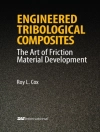Basic Helicopter Aerodynamics is widely appreciated as an
easily accessible, rounded introduction to the first principles of
the aerodynamics of helicopter flight. Simon Newman has brought
this third edition completely up to date with a full new set of
illustrations and imagery. An accompanying website href=’http://www.wiley.com/go/seddon’>www.wiley.com/go/seddon
contains all the calculation files used in the book, problems,
solutions, PPT slides and supporting MATLAB® code.
Simon Newman addresses the unique considerations applicable to
rotor UAVs and MAVs, and coverage of blade dynamics is expanded to
include both flapping, lagging and ground resonance. New material
is included on blade tip design, flow characteristics surrounding
the rotor in forward flight, tail rotors, brown-out, blade sailing
and shipborne operations.
Concentrating on the well-known Sikorsky configuration of single
main rotor with tail rotor, early chapters deal with the
aerodynamics of the rotor in hover, vertical flight, forward flight
and climb. Analysis of these motions is developed to the stage of
obtaining the principal results for thrust, power and associated
quantities. Later chapters turn to the characteristics of the
overall helicopter, its performance, stability and control, and the
important field of aerodynamic research is discussed, with some
reference also to aerodynamic design practice.
This introductory level treatment to the aerodynamics of
helicopter flight will appeal to aircraft design engineers and
undergraduate and graduate students in aircraft design, as well as
practising engineers looking for an introduction to or refresher
course on the subject.
Inhaltsverzeichnis
About the Authors.
Preface to First Edition.
Preface to Second Edition.
Preface to Third Edition.
Notation.
Units.
Abbreviations.
1 Introduction.
1.1 Looking Back.
References.
2 Rotor in Vertical Flight: Momentum Theory and Wake Analysis.
2.1 Momentum Theory for Hover.
2.2 Non-dimensionalization.
2.3 Figure of Merit.
2.4 Axial Flight.
2.5 Momentum Theory for Vertical Climb.
2.6 Modelling the Streamtube.
2.7 Descent.
2.8 Wind Tunnel Test Results.
2.9 Complete Induced-Velocity Curve.
2.10 Summary Remarks on Momentum Theory.
2.11 Complexity of Real Wake.
2.12 Wake Analysis Methods.
2.13 Ground Effect.
2.14 Brownout.
References.
3 Rotor in Vertical Flight: Blade Element Theory.
3.1 Basic Method.
3.2 Thrust Approximations.
3.3 Non-uniform Inflow.
3.4 Ideal Twist.
3.5 Blade Mean Lift Coefficient.
3.6 Power Approximations.
3.7 Tip Loss.
3.8 Examples of Hover Characteristics.
References.
4 Rotor Mechanisms for Forward Flight.
4.1 The Edgewise Rotor.
4.2 Flapping Motion.
4.3 Rotor Control.
4.4 Equivalence of Flapping and Feathering.
References.
5 Rotor Aerodynamics in Forward Flight.
5.1 Momentum Theory.
5.2 Descending Forward Flight.
5.3 Wake Analysis.
5.4 Blade Element Theory.
References.
6 Aerodynamic Design.
6.1 Introductory.
6.2 Blade Section Design.
6.3 Blade Tip Shapes.
6.4 Tail Rotors.
6.5 Parasite Drag.
6.6 Rear Fuselage Upsweep.
6.7 Higher Harmonic Control.
6.8 Aerodynamic Design Process.
References.
7 Performance.
7.1 Introduction.
7.2 Hover and Vertical Flight.
7.3 Forward Level Flight.
7.4 Climb in Forward Flight.
7.5 Maximum Level Spread.
7.6 Rotor Limits Envelope.
7.7 Accurate Performance Prediction.
7.8 A World Speed Record.
7.9 Speculation on the Really Low-Drag Helicopter.
7.10 An Exercise in High-Altitude Operation.
7.11 Shipborne Operation.
References.
8 Trim, Stability and Control.
8.1 Trim.
8.2 Treatment of Stability and Control.
8.3 Static Stability.
8.4 Dynamic Stability.
8.5 Hingeless Rotor.
8.6 Control.
8.7 Autostabilization.
References.
9 A Personal Look at the Future.
Appendix: Performance and Mission Calculation.
Index.
Über den Autor
John Seddon, Formerly of the Ministry of Defence, UK
Simon Newman, University of Southampton, UK












